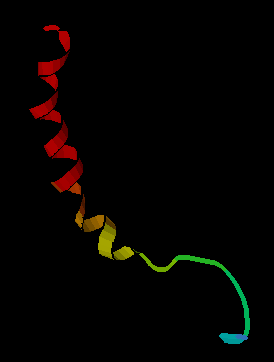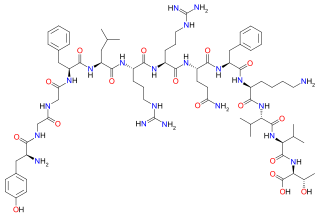Endorphins are chemical signals in the brain that block the perception of pain and increase feelings of wellbeing. They are produced and stored in an area of the brain known as the pituitary gland.

Neuropeptides are chemical messengers made up of small chains of amino acids that are synthesized and released by neurons. Neuropeptides typically bind to G protein-coupled receptors (GPCRs) to modulate neural activity and other tissues like the gut, muscles, and heart.

Neuropeptide Y (NPY) is a 36 amino-acid neuropeptide that is involved in various physiological and homeostatic processes in both the central and peripheral nervous systems. NPY has been identified as the most abundant peptide present in the mammalian central nervous system, which consists of the brain and spinal cord. It is secreted alongside other neurotransmitters such as GABA and glutamate.

beta-Endorphin (β-endorphin) is an endogenous opioid neuropeptide and peptide hormone that is produced in certain neurons within the central nervous system and peripheral nervous system. It is one of three endorphins that are produced in humans, the others of which include α-endorphin and γ-endorphin.

Opioid peptides are peptides that bind to opioid receptors in the brain; opiates and opioids mimic the effect of these peptides. Such peptides may be produced by the body itself, for example endorphins. The effects of these peptides vary, but they all resemble those of opiates. Brain opioid peptide systems are known to play an important role in motivation, emotion, attachment behaviour, the response to stress and pain, control of food intake, and the rewarding effects of alcohol and nicotine.

Endomorphins are considered to be natural opioid neurotransmitters central to pain relief. The two known endomorphins, endomorphin-1 and endomorphin-2, are tetrapeptides, consisting of Tyr-Pro-Trp-Phe and Tyr-Pro-Phe-Phe amino acid sequences respectively. These sequences fold into tertiary structures with high specificity and affinity for the μ-opioid receptor, binding it exclusively and strongly. Bound μ-opioid receptors typically induce inhibitory effects on neuronal activity. Endomorphin-like immunoreactivity exists within the central and peripheral nervous systems, where endomorphin-1 appears to be concentrated in the brain and upper brainstem, and endomorphin-2 in the spinal cord and lower brainstem. Because endomorphins activate the μ-opioid receptor, which is the target receptor of morphine and its derivatives, endomorphins possess significant potential as analgesics with reduced side effects and risk of addiction.

Corticotropin-like intermediate [lobe] peptide (CLIP), also known as adrenocorticotropic hormone fragment 18-39, is a naturally occurring, endogenous neuropeptide with a docosapeptide structure and the amino acid sequence Arg-Pro-Val-Lys-Val-Tyr-Pro-Asn-Gly-Ala-Glu-Asp-Glu-Ser-Ala-Glu-Ala-Phe-Pro-Leu-Glu-Phe. CLIP is generated as a proteolyic cleavage product of adrenocorticotropic hormone (ACTH), which in turn is a cleavage product of proopiomelanocortin (POMC). Its physiological role has been investigated in various tissues, specifically in the central nervous system.

Neurokinin A (NKA), formerly known as Substance K, is a neurologically active peptide translated from the pre-protachykinin gene. Neurokinin A has many excitatory effects on mammalian nervous systems and is also influential on the mammalian inflammatory and pain responses.

Met-enkephalin, also known as metenkefalin (INN), sometimes referred to as opioid growth factor (OGF), is a naturally occurring, endogenous opioid peptide that has opioid effects of a relatively short duration. It is one of the two forms of enkephalin, the other being leu-enkephalin. The enkephalins are considered to be the primary endogenous ligands of the δ-opioid receptor, due to their high potency and selectivity for the site over the other endogenous opioids.

Carboxypeptidase E (CPE), also known as carboxypeptidase H (CPH) and enkephalin convertase, is an enzyme that in humans is encoded by the CPE gene. This enzyme catalyzes the release of C-terminal arginine or lysine residues from polypeptides.

Dynorphin B, also known as rimorphin, is a form of dynorphin and an endogenous opioid peptide with the amino acid sequence Tyr-Gly-Gly-Phe-Leu-Arg-Arg-Gln-Phe-Lys-Val-Val-Thr. Dynorphin B is generated as a proteolytic cleavage product of leumorphin, which in turn is a cleavage product of preproenkephalin B (prodynorphin).
The neuropeptide FF receptors are members of the G-protein coupled receptor superfamily of integral membrane proteins which bind the pain modulatory neuropeptides AF and FF. The Neuropeptide FF receptor family is a member of the G protein-coupled receptor superfamily containing two subtypes, NPFF1 and NPFF2, which exhibit a high affinity for Neuropeptide FF (NPFF) peptides. NPFF1 is broadly distributed in the central nervous system with the highest levels found in the limbic system and the hypothalamus. NPFF2 is present in high density, particularly in mammals in the superficial layers of the spinal cord where it is involved in nociception and modulation of opioid functions. These receptors participate to the modulation of opioid receptor function in the brain and spinal cord, and can either reduce or increase opioid receptor function depending which tissue they are released in, reflecting a complex role for neuropeptide FF in pain responses.

VGF or VGF nerve growth factor inducible is a secreted protein and neuropeptide precursor that may play a role in regulating energy homeostasis, metabolism and synaptic plasticity. The protein was first discovered in 1985 by Levi et al. in an experiment with PC12 cells and its name is non-acronymic. VGF gene encodes a precursor which is divided by proteolysis to polypeptides of different mass, which have a variety of functions, the best studied of which are the roles of TLQP-21 in the control of appetite and inflammation, and TLQP-62 as well as AQEE-30 in regulating depression-like behaviors and memory. The expression of VGF and VGF-derived peptides is detected in a subset of neurons in the central and peripheral nervous systems and specific populations of endocrine cells in the adenohypophysis, adrenal medulla, gastrointestinal tract, and pancreas. VGF expression is induced by NGF, CREB and BDNF and regulated by neurotrophin-3. Physical exercise significantly increases VGF expression in mice hippocampal tissue and upregulates a neurotrophic signaling cascade thought to underlie the action of antidepressants.

NPFF Neuropeptide FF (FLFQPQRFa) is a mammalian amidated neuropeptide originally isolated from bovine brain and characterized as a pain-modulating peptide, with anti-opioid activity on morphine-induced analgesia.

Adrenorphin, also sometimes referred to as metorphamide, is an endogenous, C-terminally amidated, opioid octapeptide (Tyr-Gly-Gly-Phe-Met-Arg-Arg-Val-NH2, YGGFMRRV-NH2) that is produced from proteolytic cleavage of proenkephalin A and is widely distributed throughout the mammalian brain. It was named based on the fact that it was originally detected in human phaeochromocytoma tumour derived from the adrenal medulla, and was subsequently found in normal human and bovine adrenal medulla as well. Adrenorphin exhibits potent opioid activity, acting as a balanced μ- and κ-opioid receptor agonist while having no effects on δ-opioid receptors. It possesses analgesic and respiratory depressive properties.
Bombesin-like peptides comprise a large family of peptides which were initially isolated from amphibian skin, where they stimulate smooth muscle contraction. They were later found to be widely distributed in mammalian neural and endocrine cells.

α-Endorphin is an endogenous opioid peptide with a length of 16 amino acids, and the amino acid sequence: Tyr-Gly-Gly-Phe-Met-Thr-Ser-Glu-Lys-Ser-Gln-Thr-Pro-Leu-Val-Thr. With the use of mass spectrometry, Nicholas Ling was able to determine the primary sequence of a-endorphin.
FMRFamide, a neuropeptide involved in cardiac activity regulation, is found in Biomphalaria glabrata, a species of a freshwater snail best known for its role as the intermediate host for the human-infecting trematode parasite Schistosoma mansoni.
Neuropeptide VF precursor, also known as pro-FMRFamide-related neuropeptide VF or RFamide-related peptide precursor, is a propeptide that in mammals is encoded by the NPVF (or RPFP) gene. The NPVF gene, and thus the propeptide, are expressed in neurons in the mediobasal hypothalamus. The propeptide is cleaved to form three other peptides, which are:
The RFamide peptide family, or the RFamide-related peptides (RFRPs), are a family of neuropeptides. They are characterized by the possession of an Arg-Phe-NH2 motif at their C-terminal extremities.













